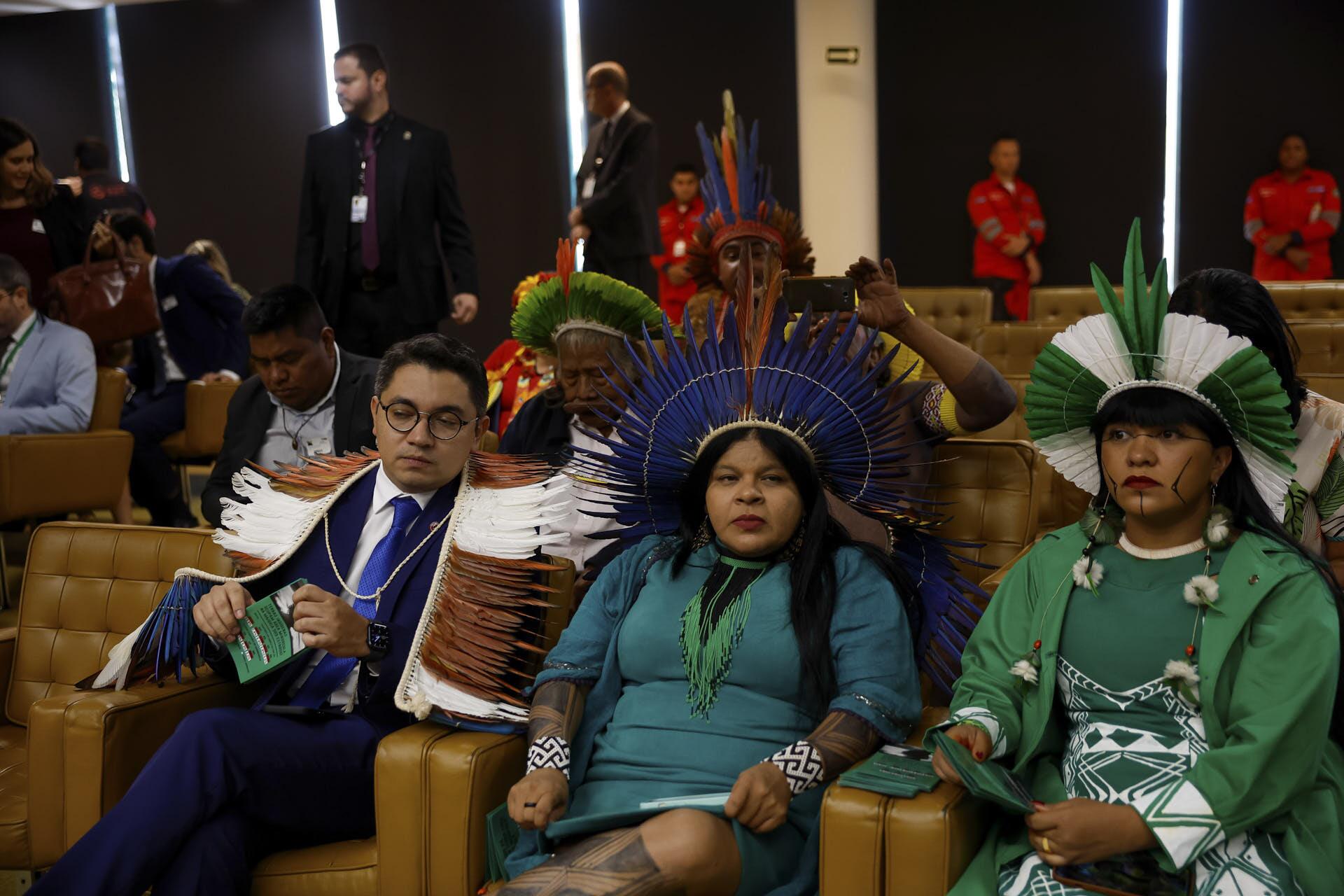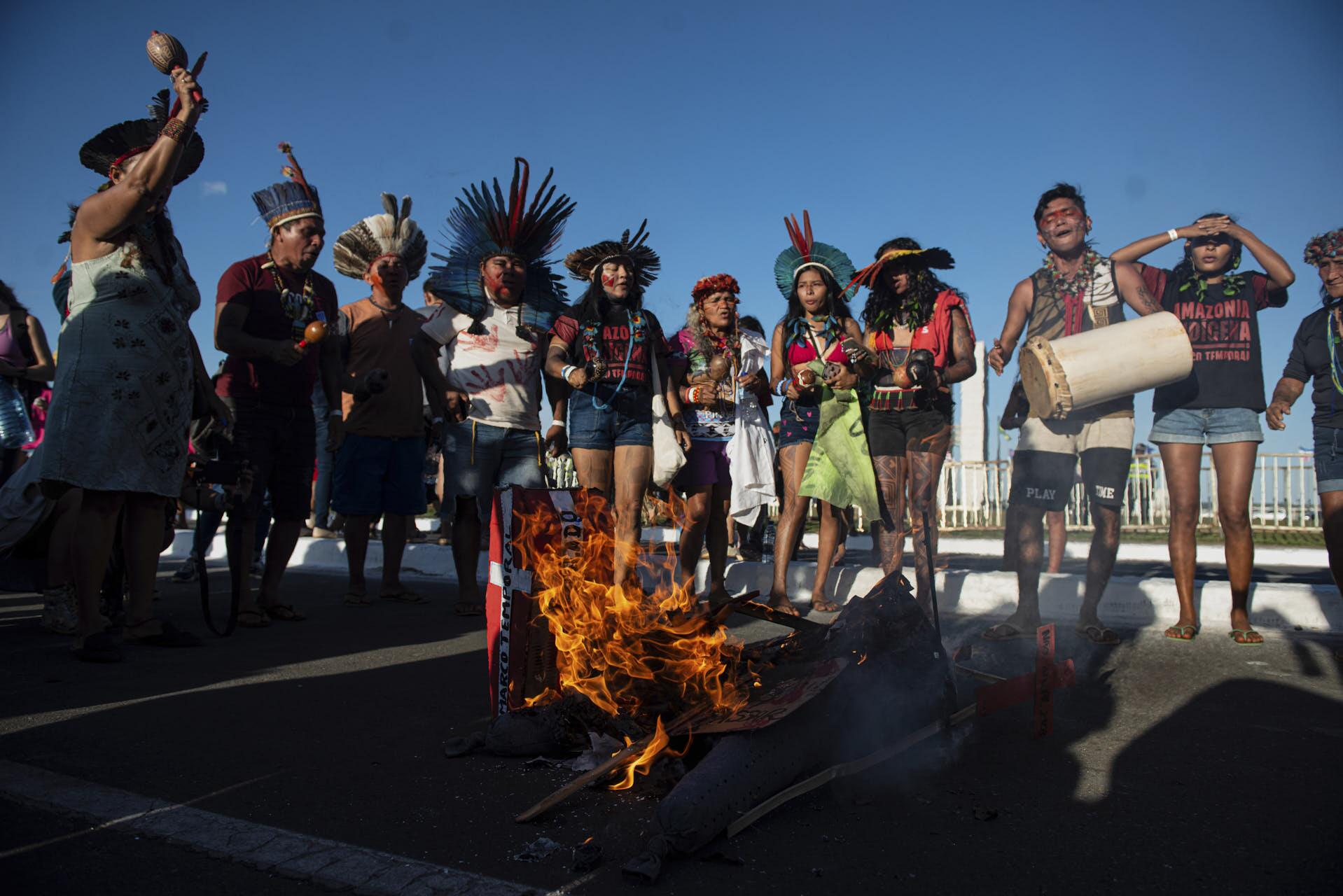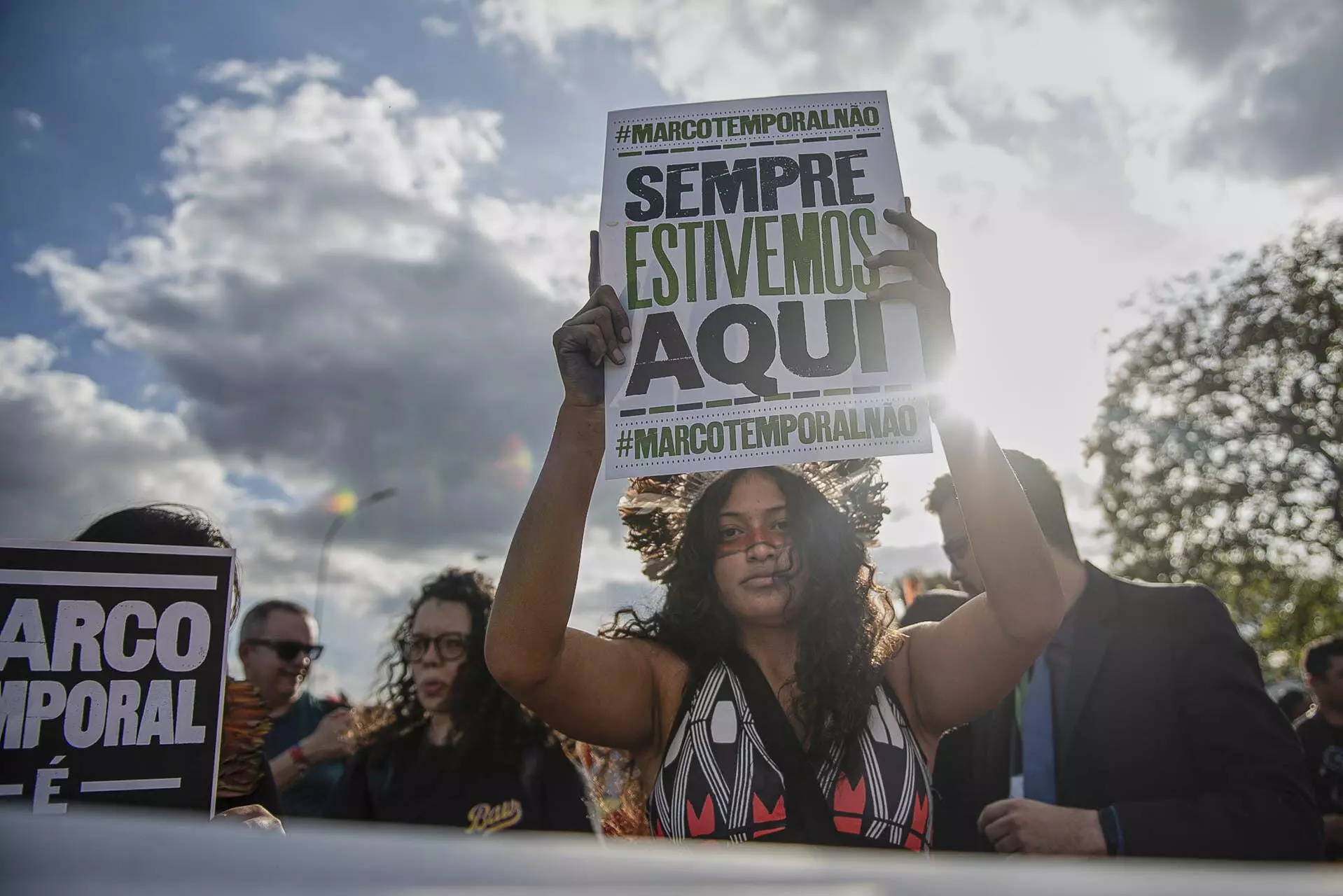Two expressions by Brazilian Federal Supreme Court minister Alexandre de Moraes worry attorneys for original peoples in court hearings on a bill to implement a historic cut-off point for the demarcation of Indigenous lands. The case is considered the “trial of the century” for Indigenous peoples and for conservation of areas vital to tackling the climate emergency.
The first worrisome expression is “prior indemnification” for farmers or executives who claim to own traditional Indigenous lands. If the other justices agree with Moraes’ opinion, it could create an obstacle – financial and bureaucratic – that currently does not exist for new demarcations, according to attorneys who spoke with SUMAÚMA.
The second is the possibility of “compensating territories in the public interest” – in other words, the federal government would offer a group of Indigenous people an alternative territory to the territory they intended to see demarcated. In practice, this would allow for the removal of Indigenous peoples from their territories, a measure widely practiced during the business-military dictatorship (1964 to 1985). The proposal reduces the concept of land to a thing that can be exchanged or replaced, violating the profound cultural connection that the hundreds of original peoples have with their ancestral territories.
The minister’s two proposals will worsen an already serious problem in the Amazon, according to Indigenous attorney Mauricio Terena, a legal coordinator with the Alliance of Indigenous Peoples of Brazil (Apib). “It’s going to encourage illegal land grabs,” he says, referring to the invasion of unused public areas, so-called vacant lands, by rural squatters and farmers. Many of these lands are also claimed by Indigenous peoples – especially in the Amazon.
“The tendency is for conflicts to heat up,” agrees Rafael Modesto, an attorney with the Indigenist Missionary Council (Cimi) and for the Xokleng people of Santa Catarina. “With prior indemnification, Moraes is creating a new phase in the demarcation process,” he adds. The demarcation process has already proven to be much slower than it should be, ramping up conflicts and causing murders in the Amazon and in most of the biomes.
“We’ve never opposed indemnification, we feel it’s a measure of justice, especially when it involves small farmers,” explains Deborah Duprat, a former federal deputy attorney general who is currently representing Indigenous peoples in court hearings on the historic cut-off point. “But the indemnity has to be discussed in a separate legal process, and not in the course of the administrative process of demarcation.”
His defense of territorial compensation shows that Moraes “doesn’t understand” the relationship between Indigenous peoples and their traditional territories, says Modesto. “The possibility of compensating one territory with another does not consider the peoples’ relationship to their original land, which is psychic, spiritual. The traditional land is the place where the ancestors are buried, it’s a place of worship, of myths, it goes beyond the civil and patrimonialist compression of non-Indigenous people,” he argues.
This is why most of the lawyers defending the Indigenous cause in court hearings on the historic cut-off point regard Moraes as “wicked,” even though he dismissed the argument that original peoples can only claim ownership of territories they were occupying on October 5, 1988, the date when the constitution was enacted.
In addition to the worsening problem of territorial disputes in the Amazon region, the two arguments found in Moraes’ opinion clash with the provisions of Article 231 of the Constitution, which states that Indigenous lands are federal property and are “allotted for permanent ownership by Indians.” What’s more, the Constitution says that acts to occupy Indigenous territories “produce no legal effects” or entitlement to indemnification — something that Moraes aims to change with his opinion. Finally, this same article affirms that “removal of Indians from their territories is prohibited.”

The head of the Ministry of Indigenous Peoples, Sônia Guajajara, and the leader of the Raoni take part in a Federal Supreme Court session resuming hearings on the historic cut-off point. Photo: Pedro Ladeira/Folhapress
The Supreme Court resumed hearings on June 7, with Moraes reading his opinion. Up to then, the score had been one vote against the historic cut-off point – from the rapporteur, Justice Edson Fachin – and one in favor – from Justice Nunes Marques, who was appointed to the court by extreme-right former president Jair Bolsonaro.
The hearing was once again interrupted after another Bolsonaro appointee, André Mendonça, asked to take the case under advisement. Justices can ask to take a case under advisement if they need more time to assess it before making a decision – and it can also be used to postpone rulings where they are at a disadvantage. Mendonça has ninety days to return the case for plenary hearings. However, because the Supreme Court is in recess in July, in practice the historic cut-off point might only be back on the docket in October.
A middle way or permission for new conflicts?
Two weeks after hearings resumed, Alexandre Moraes’ entire written opinion has yet to be added to the trial documents for the case, a ruling on which will determine whether the bill to demarcate Indigenous lands based on a historic cut-off point is or is not constitutional. Attorneys who spoke with SUMAÚMA explained that only after this happens will a consolidated assessment of the bill be possible.
After reading his opinion, Moraes listed the considerations that led to his rejection of the historic cut-off point argument in ten items. At first glance, they seem to summarize a sort of “middle way” – between what Fachin proposed in his report and the dissenting opinion from Nunes Marques in favor of the historic cut-off point. Attorneys for the Indigenous cause suspect that it is possible that this “middle way” is the result of prior consensus among the justices who have yet to rule. It is in one of these items that these worrisome terms appear.
Item 4 in Moraes’ final ruling is available in a document attached to the case on the Supreme Court’s website. In it, the justice states that if the Indigenous people were not in – or were fighting for – the territory they want to see demarcated, ownership documents for that area will then be valid. And because of this, the “owner” of the lands will need to be indemnified in advance by the federal government in order for demarcation to occur. If the justice’s opinion prevails, it will produce a shift in relation to the constitution, which solely establishes indemnities “for good faith improvements” made by non-Indigenous occupants.
Good faith improvements are generally those done by people and families, mostly rural squatters, smallholders looking for ways to exist, who adhered to some type of government program in the past that led to their occupation of an Indigenous territory. Impoverished people from Brazil’s northeast were, for example, called upon to extract latex from rubber trees for rubber manufacturing and were later abandoned in the Amazon forest following a drop in rubber prices. There is a stark difference between cases like this and the land-grabbers, who seek to illegally appropriate large areas of public lands, oftentimes ancestrally occupied by Indigenous people, divvying up private property and becoming landowners.
In item 5 of his summarized opinion, Moraes states: “With the dismantling of the consolidated situation being contrary to the public interest and aimed at social peace, the federal government may compensate Indigenous communities, granting them lands equal to those traditionally occupied, provided there is express agreement.” Put another way, he says that if there is “public interest” for a traditional Indigenous territory not to be allotted to the original peoples who claim it, the federal government may offer an area of equal size.
This is a response that Deborah Duprat calls the “Copacabana effect” – the claim that, since Indigenous peoples lived everywhere in Brazil before it was invaded by the Portuguese, there would be no limits on demarcations; even cities that have existed for centuries could be declared Indigenous territories – the case of the famous beach in Rio de Janeiro. Widespread by landowners and other staunch adversaries of the Indigenous cause, this argument has even already been made by Supreme Court Justice Gilmar Mendes.
The lawyers who talked to SUMAÚMA counter that this is a fallacy. Right now, the anthropological reports guiding the process of demarcating Indigenous territories already exclude consolidated areas of non-Indigenous occupation – such as cities already recognized in Brazil. Yet to solve a problem that doesn’t exist, Moraes has created the possibility of another problem – and this one is, indeed, serious.
Mentioning the “public interest” is particularly explosive. “This part of the opinion has various problems, starting with the expression ‘public interest,’ where anything can fit,” Duprat opines. “And, in practice, it’s going to turn Indigenous lands into a shop counter, it’s going to foster divisions in communities [so that they give up their land]. Records from the Inter-American Court of Human Rights show that this strategy of dividing communities to gain consent [on leaving territories] is common in countries with Indigenous populations.”
The possibility opened up by Moraes’ opinion has significant potential to become a “forced removal.” “Compensation of territories [of an ancestral area claimed by Indigenous peoples for another area that is, in theory, equal] is an ‘agreed forced removal,'” says Mauricio Terena ironically. The irony points to the predictable result of a negotiation between parties whose political and economic strengths are very unequal.
During the dictatorship, forced removals of Indigenous peoples were common on territories coveted by landowners or targeted by the expansionist policy of the military leaders in power. Taken to territories with which they had no relation, many Indigenous people walked hundreds of kilometers in an attempt to return to the lands to which they belonged. Many died along the way. In his book on the Indigenous resistance during the dictatorship, “Os Fuzis e as Flechas – História de Sangue e Resistência Indígena na Ditadura” (Companhia das Letras, 2017), journalist Rubens Valente reports on cases like that of the Nambikwara people. Pressured by farmers who came when the BR-364 highway opened and occupied (with authorization from the National Foundation of Indigenous Peoples – Funai) their traditional territory in the Guaporé Valley, between Mato Grosso and Rondônia, they were targeted by two removals in 1971 and 1974. The second removal “operation lasted over four days of flights on an airplane provided by Funai, traveling two more days by truck.” Their destination was lands with poor and sandy soil, bad for planting and with little game. The result, both times, was the same: the Indigenous people, “starving on poor soil, began to spontaneously return to their original lands. By foot or hitching a ride, they returned one by one,” the journalist reports.
With his former attorney on the Supreme Court, Lula gets in the game
With ninety days to go until André Mendonça returns the historic cut-off point case and with the court in recess during the entire month of July, hearings are only likely to resume in October. That is also when the current chief justice of the Supreme Court, Justice Rosa Weber, will be forced to retire after she turns seventy-five. She is seen as inclined to rule in favor of the Indigenous people, nature, and confronting the climate collapse. In the June 7 session, she indicated a desire to rule. The court’s newest member, Cristiano Zanin (Luiz Inácio Lula da Silva‘s attorney during the Operation Car Wash proceedings, who will take over the spot left vacant by Ricardo Lewandowski’s retirement), should also take a position on the case.
In the Senate debate on June 21, Zanin was on the fence when questioned about the historic cut-off point. He talked about “values that will have to be reconciled, as is the case of the right to property and the right of the original peoples” – a sign that his interpretation is similar to Moraes’. “The Indigenous people know that President Lula is the biggest backer of Zanin on the Supreme Court,” says one attorney, who agreed to speak anonymously about who should be held accountable if the new justice and former lawyer for the president rules against the interests of the original peoples and of the next generations. By making a personal choice for a public position, a decision that has brought on criticism from the right to the left, Lula has put himself in a vulnerable position for all of the Supreme Court’s sensitive decisions.
Despite some pessimism brought about by the possibility that Moraes’ ruling is the result of consensus between the justices, Mauricio Terena says that the Indigenous peoples will keep working for the position taken by rapporteur Edson Fachin to prevail: “Until the boat sinks, Apib will stick with Justice Fachin’s opinion. Because this will go down in the history books.”
Translation into Spanish: Meritxell Almarza
English translation: Sarah J. Johnson
Photography editing: Marcelo Aguilar, Mariana Greif and Pablo Albarenga
Page setup: Érica Saboya

Indigenous people hold a vigil in front of the Federal Supreme Court in early June, during what is being considered the trial of the century for the climate emergency. Photo: Matheus Alves/SUMAÚMA






